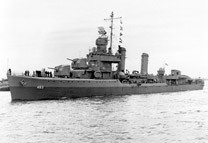
USS Corry (DD-463)
THE SHIPS CALLED DESTROYERS
 |
USS Corry (DD-463) |
|
“The
destroyer’s best years were WWII. She could sink a BB (battleship) or
cruiser with five steam torpedoes, chase down and blast submarines…, give
fire support to troops ashore and those landing; or could shuttle admirals
and generals, and pick up downed pilots. There was no ship like the
destroyer.”
From
United States Destroyer Operations in World War Two
Destroyers Online -- http://www.destroyersonline.com/usndd/
“Of all the tools the Navy will employ to control the seas in any future war, the most useful of the small types of combatant ships, the destroyer, will be sure to be there. Its appearance may be altered and it may even be called by another name, but no type—not even the carrier or the submarine—has such an assured place in future navies.” —Fleet Admiral
Chester W. Nimitz
|
THE HISTORY OF THE SHIPS CALLED DESTROYERS
|
In the late 1800s, navies that had big battleships suddenly faced the threat of much smaller vessels called torpedo boats. These boats, fast, agile, and relatively very small, did not attack with artillery guns. Instead, they fired torpedoes capable of sinking the massive battleships. Moving rapidly through the water and changing their course frequently, the torpedo boats could evade shellfire from the larger ships and quickly disappear over the horizon.
Previously, the only real threat to a battleship had been another huge warship with guns large enough to cause destruction through the side armor of a battleship. Countries that could not afford to build big battleships could easily afford several torpedo boats. These countries were now able to face off against larger navies that had fleets of battleships.
To protect their slower battleships, countries with large navies developed a new, smaller ship with artillery guns that was also fast and agile; one that while escorting the much larger ships was well able to pursue, attack, and destroy torpedo boats. These fast new ships were called torpedo boat destroyers. Quickly, however, their name was shortened and they became known simply as destroyers.
The destroyers also carried torpedoes, which made them as offensively capable as the torpedo boats had been. Destroyers were later additionally equipped to attack submerged submarines with depth charges (underwater bombs) that detonated at a predetermined depth by water pressure. And, being much smaller than a battleship, the destroyers possessed speed and maneuverability that enabled them to get in close to the beaches and use their guns to provide additional shore bombardment and very accurate fire support for troops on the land. |